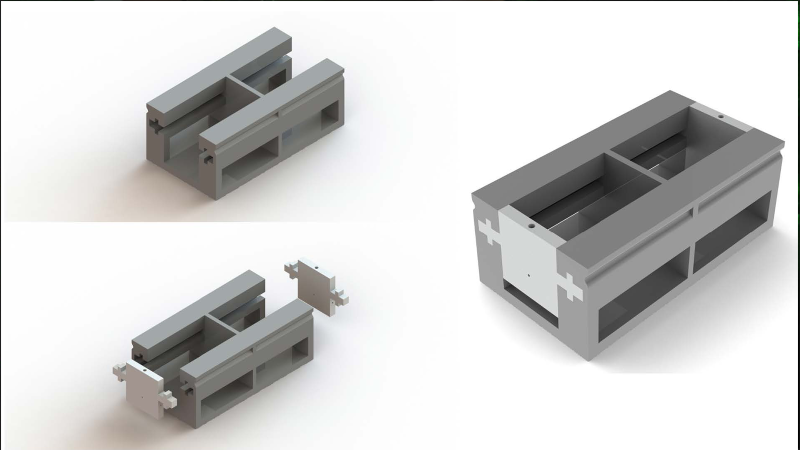
3D rendering of the microchip holder, showing the the fixed part in grey and the sliders in white. Image credit: Dr Ram Chepyala
Microfluidics refers to the flow of a few microliters of fluids in micrometre-sized channels. For such flows, properties such as surface tension and fluidic resistance dominate how the system behaves. Manipulating fluids using capillary forces or microvalves and micropumps is used in a wide range of applications, including sensors, controllers, diagnosis and treatment of diseases including cancer, and our so familiar inkjet printers! The diagnostics and pharmaceuticals market is predicted to grow in India, and researchers need to be able to have a flexible and reliable experimental setup.
A common way to experiment and test microfluidic systems is to use a microfluidic chip. It has a network of microchannels made of a polymer such as PDMS (PolyDimethylSiloxane) or plastic on a substrate—typically a slide of glass or transparent materials used to view specimens under a microscope. Fluids are injected and extracted from the chip through small holes in the microchannels at the input and output. Researchers need to control the flow of the fluid and measure pressure, temperature and other parameters at the inlets and outlets of the system. Fluids are commonly injected into the test system using a syringe or a micropump, which implies attaching tubing and sensors in the tiny space available on the microfluidic chip.
Dr Ram Chepyala and Prof Siddhartha Panda of the Indian Institute of Technology, Kanpur, have designed a portable microfluidic chip holder with multiple ports on a sliding port holder. Chepyala and Panda have been granted a patent in India for the design of their portable microfluidic chip holder, which makes experimenting with microfluidic chips easier. The patent specifies the design of a chip holder with multiple ports and a sliding port holder. The device and the port holder can be manufactured for a specific application using a wide range of materials, from simple plastic or metal to materials that can withstand high pressure and temperature.
For a microfluidics experiment, researchers need to connect sensors and probes to continuously measure pressure, temperature, pH and certain electrical properties of the fluids at the inlet and the outlet. Attaching and removing the sensors to each microfluidic chip can introduce inconsistencies. Reproducibility is a challenge researchers often face during microfluidics experiments. Researchers may need to view the reaction under a microscope in certain biochemical reactions. Most microscopes need the slide to be at a distance of a few millimetres from the lens, but the sensors and tubing attached do not allow easy viewing of the microfluidic slide through a microscope.
Chepyala and Panda’s chip holder overcomes the difficulties in integrating fluid-carrying components in microfluidic experiments. It is typically the size of a matchbox, though it can be custom manufactured to be of any desired size. It has a fixed part and an arrangement for sliders that can slide like a drawer in the fixed part. One slider can be used for each inlet and outlet.

Schematic of a slider of the chip holder
The slider has a bottle-shaped microcavity inside it, with the mouth of the bottle opening in a hole on the top surface. Fluid flows in or out of the microfluidic chip through this hole. There are four threaded holes (ports) on each side of the slider (see diagram), each of which can be used to inject liquid or place a sensor. Measuring electrical potential or current would need using two ports. The fixed portion of the chip holder has spring-loaded clamps to hold the microfluidic chip. One needs to align the inlet and outlet ports of the microfluidic chip to the top port of the respective slider by sliding the slider at the correct position.
The chip holder allows changing the microfluidic chip under test without disturbing the sensor setup, thus allowing consistent measurement. The spring-loaded clips (not shown in figure) ensure that the mounted microchip does not move, adding reliability to the setup. Also, since the tubing for sensors and inlet and outlet attach from the sides of the holder, access to the microfluidic chip top-surface remains free, allowing easy viewing of the surface of the chip. Thus, the reactions can be observed using any simple or complex microscope.
Commercial chip holders currently available in the market are expensive (more than a lakh rupees) and do not have all the features offered by Chepyala and Panda’s design.
Dr Ram Chepyala says, “If manufactured commercially, our chip holders can be sold at just about 10% of the price of the currently available commercial chip holders.”
The researchers are looking for industry partners who can licence the design and manufacture of the chip holders. A chip holder based on Chepyala and Panda’s robust and flexible design is a promising cost-effective product that can help the growing microfluidics market in India.
This article has been run past the researchers, whose work is covered, to ensure accuracy.

![Inset: image of Snowflake yeast. Credit: Narayanasamy N, Bingham E, Fadero T, Ozan Bozdag G, Ratcliff WC, Yunker P, Thutupalli S. Metabolically-driven flows enable exponential growth in macroscopic multicellular yeast. bioRxiv [Preprint]. 2024 Jun 22:2024.06.19.599734. doi: 10.1101/2024.06.19.599734. PMID: 38948761; PMCID: PMC11213004. Yeast](/sites/researchmatters/files/styles/400px_wide/public/Snowfalke%20Yeast.jpg?itok=YZoahBjb)




